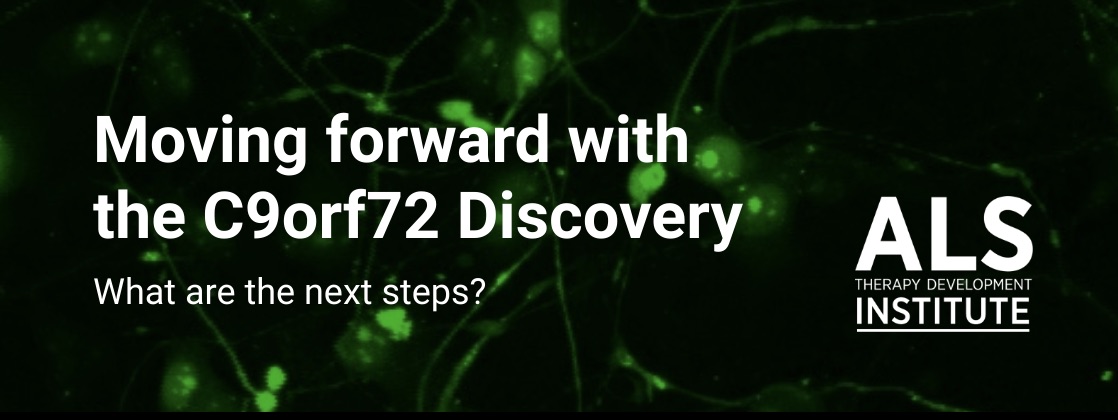
In September of 2020, scientists with the ALS Therapy Development Institute (ALS TDI) published a paper outlining their discovery of an exciting new potential drug target, arginine methylation, for C9orf72-related amyotrophic lateral sclerosis (ALS). This is significant because C9orf72 is the most common known mutation found in people with familial ALS, and has also been seen in some cases of sporadic ALS.
This month, they follow up that 2020 publication with a second paper, Hypothesis and Theory: Roles of Arginine Methylation in C9orf72-Mediated ALS and FTD, published in the journal Frontiers in Cellular Neuroscience.
Building Upon Our 2020 Discovery
The recent paper, authored by ALS TDI’s Associate Scientist Anna Gill, Associate Scientist Alan Premasiri, and Chief Scientific Officer Dr. Fernando Vieira, examines the findings of their earlier study in the context of work done by other researchers in the fields of ALS and neurodegeneration. The 2020 paper, by the same authors, demonstrated that by inhibiting certain PRMTs (a class of enzymes that post-translationally modify proteins), the scientists were able to protect against C9ORF72 arginine-rich dipeptide repeat toxicity. Specifically, they found that they could protect cells from C9ORF72 dipeptide repeat toxicity by inhibiting the PRMTs that cause asymmetric dimethylation, a specific molecular modification, to the amino acid, arginine. These are also known as Type I PRMTs. The results suggested that inhibition of asymmetric dimethylation could be protective against C9ORF72 ALS or also C9ORF72 frontotemporal dementia (FTD). (For a detailed explanation of this process, see this video.)
Exploring the Protective Processes
Having shown this process’ protective effects, the next step was to investigate why it was working. In this new paper, the authors outline a number of potential hypotheses as to what might be behind this protective effect. To do this, they undertook an extensive review of the literature around PRMTs and the cellular effects of asymmetric dimethylation, resulting in a paper that cites more than 120 previous studies. They identified several of ways in which the arginine-rich dipeptides GR and PR – potentially toxic proteins that appear in C9ORF72-related ALS – can interact with each other, other proteins in the cell, and with RNA molecules, depending on whether they’ve undergone asymmetric dimethylation or other, similar processes.
They also focused in on several reasons why asymmetrically dimethylated GR and PR proteins appear to be so toxic. The paper hypothesizes how these proteins could affect processes including stress granule assembly and function, chromatin remodeling, and RNA splicing – all processes whose dysfunction is associated with ALS. It goes on to postulate that some or all of the damage caused by these processes could be repaired utilizing compounds that inhibit the Type I PRMTs that cause asymmetric dimethylation.
The fact that asymmetrically dimethylated proteins are involved in so many different processes related to ALS makes this a particularly exciting drug target, according to Gill.
“One of the virtues of showing all of those different processes, and how Type I PRMTs may influence each of them, shows this could be a broad fix to the problem,” she says. “Say each of these is happening at the same time. Being able to find a class of drugs that might mitigate these problems in each of those areas would be important.”
While the paper focuses on the possible effect of proteins found in C9ORF72 related ALS in these processes, they may also occur in many different forms of genetic – and even sporadic – ALS. This means that Type I PRMTs could also possibly be a target for other forms of the disease.
Identifying Potential Treatments
The authors are presenting this information to describe how the ALS TDI lab will continue to investigate the potential of Type 1 PRMT inhibitors as treatments for ALS, but also as a message for others in the biotech and pharmaceutical industries that this is an ALS drug target that shows promise. While this is a new target in the ALS space, there are some biotech companies that already have Type I PRMT inhibiting drugs in their pipelines for conditions like cancer – and there is hope that these findings might lead them to consider testing these treatments in ALS.
“We wanted to lay out a road map for people who have worked in each of those domains to consider connecting these dots in their own labs,” says Dr. Vieira. “We're going to pursue many of these pathways, but we definitely can't investigate all of them simultaneously.”
“This is essentially unexplored in ALS.” adds Alan. “So, this is a call to action.”
To learn more about ALS TDI’s research to end ALS, click here.
Key Take-aways:
In science, it is often said that one new answer produces many new questions. A recent discovery by ALS TDI scientist suggesting that a family of enzymes, PRMTs, are promising drug targets for ALS is no different.
- In a recently published paper, ALS TDI scientists follow-up on their C9orf72 drug target discovery to explain next step for our lab and encourage other biotechs to get involved in testing potential treatments.
- The paper is a follow-up to their September of 2020 publication which outlined their discovery of a promising drug target for C9orf72-related Amyotrophic Lateral Sclerosis (ALS). The 2020 report by ALS TDI scientists showed that cells could be protected from C9orf72 associated toxicity by inhibiting a class of enzymes (Type I PRMTs).
- In this new paper, the authors outline a number of potential hypotheses as to what might be behind this protective effect. They identified several of ways in which the potentially toxic proteins that appear in C9ORF72-related ALS – can interact with each other, other proteins in the cell, and with RNA molecules.